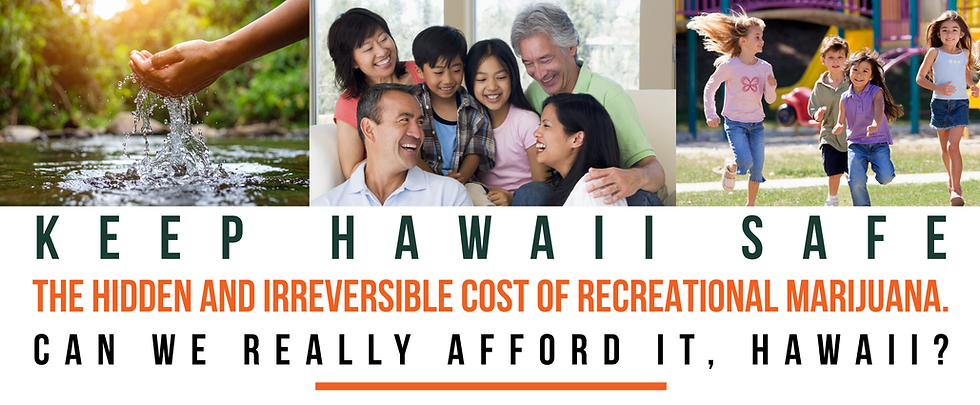Medical Access Stays Protected. BUT RECREATIONAL? LET'S KEEP OUR ‘OHANA SAFE FIRST!
Before we rush into recreational marijuana, let's stop and think about this. Hawaiʻi already faces crime, a strained economy, and systems stretched way too thin. Additional burdens of more enforcement, more regulation, more social fallout is not progress.
Chasing a tax dollar today will NOT cover the true costs tomorrow.
The research is clear: legalization comes with higher health costs, more public safety risks, and deeper impacts on families and communities. Much of the damage is hidden, unforeseen, and at the very worst...IRREVERSIBLE.
We are not locals who oppose freedom. We are doing our homework because we are PRO-HEALTH, PRO-SAFEY, AND MOST OF ALL PRO-‘OHANA. We are searching for neutral data sources, and sharing what we find with all of you so we can all make more thoughtful and informed decisions that protect everything we hold dear.
SURPRISING FACTS WE LEARNED FROM OTHER STATES
WHO DIDN'T SEE THE TROUBLES THEY'D HAVE TO FACE:
These Are THE BIG 3 Hawaii Locals and Lawmakers Are Not Thinking About Or Prepared For:
OUR ‘AINA + WAI SHOULD NEVER BE SOLD OUT
THESE BAD GUYS ARE DIFFERENT
WHY RISK OUR KEIKI'S SAFETY
4 Other Areas That We Really Need To Understand Because It Will Change Hawaii As We Know It:
TOURIST PROFILE CHANGES
ACCIDENTS INCREASE
DEVELOPING BRAINS SUFFER
TAX DOLLAR VS WHAT'S PRICELESS
What is SAM and Why You Should Read It & Share It...
About the SAM Report:
The SAM Report is a non-profit publication that compiles official government and academic data to show the real outcomes of marijuana legalization in the United States and abroad. It provides lawmakers and the public with a clear snapshot of the impacts on health, safety, youth, schools, the environment, and crime. Unlike advocacy groups, the SAM Report relies on neutral sources such as the CDC, NIDA, and state agencies. It is used nationwide to help communities and legislators understand the true costs of marijuana legalization.
IMPACT ON PHYSICAL AND MENTAL HEALTH:
-
"Teen marijuana use increases risk of psychosis by 400%"
-
Source: The Lancet Psychiatry
-
Link: The Lancet Psychiatry
-
-
"30% of marijuana users have some form of marijuana use disorder"
-
Source: National Institute on Drug Abuse (NIDA)
-
-
"The average potency of marijuana flower increased from 3.75% THC
in 1995 to 15.8% in 2018."-
Source: ElSohly et al., 2016
-
-
"Colorado saw a 46% increase in hospitalizations due to Cannabis
Hyperemesis Syndrome within five years of legalizing recreational
marijuana."-
Source: Wang et al., 2017
-
Link: Wang et al., 2017 Study
-
-
"Persistent cannabis use was associated with a significant decline in
IQ, particularly when use began in adolescence."-
Source: Meier et al., 2012
-
Link: Meier et al., 2012 Study
-
IMPACT ON PUBLIC SAFETY:
-
"Compared with never users, participants who used high-potency
cannabis daily had 4x higher odds of psychosis."-
Source: Di Forti et al., 2019
-
-
"Colorado’s crime rate increased by 11% in the years following marijuana legalization."
-
Source: Colorado Bureau of Investigation
-
-
"California’s black market for marijuana is still three times larger than the legal market, despite legalization."
-
Source: Los Angeles Times, 2019
-
CLICK THE IMAGE TO READ THE LATEST SAM REPORT
IMPACT ON ECONOMY:
-
"For every $1 in marijuana tax revenue, states incur $4.50 in public health and safety costs."
-
Source: Rocky Mountain HIDTA Report, 2019
-
-
"Legalization fuels black markets. Cartels thrive. Violence escalates."
-
Source: United Nations Office on Drugs and Crime (UNODC)
-
IMPACT ON ENVIRONMENT:
-
"Marijuana farming has destroyed 1.5 million acres of forest."
-
Source: Journal of Environmental Management
-
-
"Illegal marijuana grows are draining rivers and poisoning wildlife."
-
Source: Environmental Protection Agency (EPA)
-
-
"Marijuana cultivation uses an average of 1.8 gallons of water per plant per day, depleting local water resources."
-
Source: Bauer et al., 2015
-
Link: Bauer et al., 2015 Study
-










